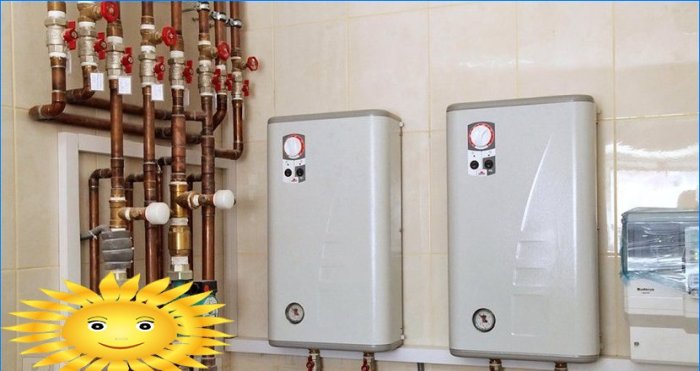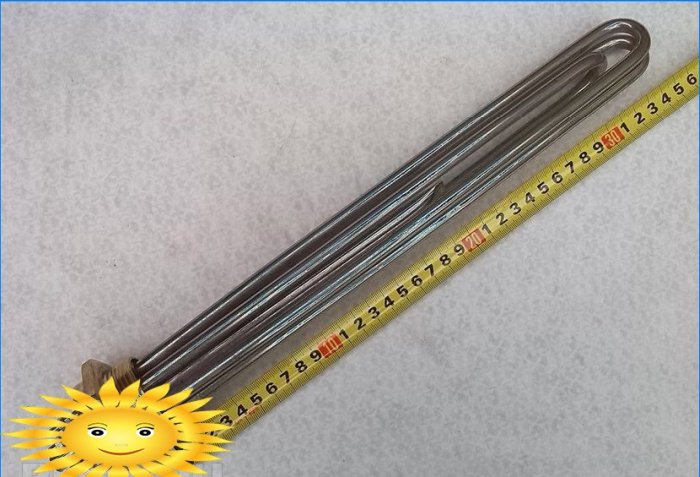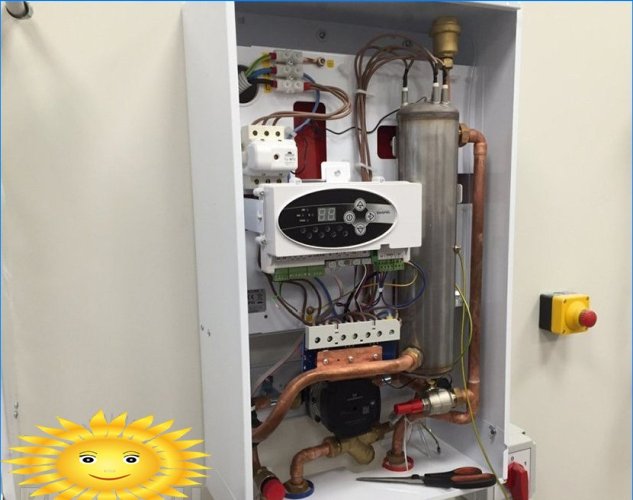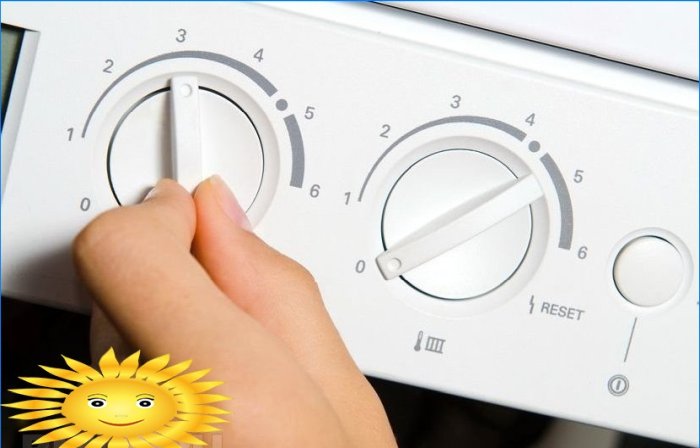Recommendation points
- Power gradations
- Varieties of electrical circuits
- Differences in the type of heating element
- Design features
- Automation and safety schemes
Although the efficiency of energy conversion in electric boilers is one of the highest, devices can vary in type and usability. We have prepared an overview of the main varieties of electric heating technology for liquid heat transfer systems.
Power gradations
It is necessary to understand the difference between electric boilers for domestic and industrial use. If, for example, take one of the leading manufacturers on the market – “EVAN” – in its model range you can find heating installations with a capacity of up to 1.6 MW, while for civilian housing the “ceiling” of the electrical network load is usually 20-25 kW.
Wall-mounted electric boiler “EVAN”
The ergonomics of an electric boiler is much more important than its peak power. High efficiency of operation is achieved if the device has several heating elements, which, when turned on in different combinations, are able to generate exactly the amount of thermal energy that is needed at the current temperature regime.
Electric boiler Protherm
The most profitable in this regard can be called boilers manufactured by Protherm or Zota – the number of stages reaches 4–5, in addition, the heaters have different power ratings. Ferroli technology, for example, implements a digital power control circuit with automatic adjustment, and in the WARMOS model range of the already mentioned manufacturer “EVAN”, the heaters are not turned off, but are controlled by the PWM method with a proportional increase in heating intensity. The lack of constant switching of the switching unit has a beneficial effect on the durability of contact groups, power consumption, voltage drops and load on the power grid are also less pronounced.
Electric boilers ZOTA
Given that the general indicator when choosing a power is 1 kW for every 10 m2 the heated area, the main reference point should be the real heat loss of the building. It is also necessary to provide a power reserve of about 15-20% so that the equipment does not work for wear and tear and in case of abnormally low outdoor temperatures.
For a domestic manufacturer, the price tag for 1 kW of power is about 2–2.5 thousand rubles, for imported equipment – up to 3–3.5 thousand rubles. Boilers designed for installation in technical rooms are always cheaper than those with an aesthetic outer casing.
Varieties of electrical circuits
Most household boilers with three-phase and single-phase connections have a universal connection scheme for heating elements and can be easily adapted to work for a certain type of supply network. This tendency persists at a maximum power of up to 12-16 kW, higher heating elements are already used without a neutral connection point. Naturally, if there is a three-phase input to the house, you should choose the appropriate class equipment to ensure the symmetry of the load. However, multiphase boilers can also be used when connected to a 220 V network: three different heating elements give more freedom in power regulation.
Electric boiler “EVAN” WARMOS “Comfort” 7.5 kW (220V / 380V) with three-stage power regulation: 1 – outlet pipe; 2 – terminal block; 3 – block for connecting the circulation pump; 4 – indication of power steps; 5 – indication of the lack of coolant; 6 – indication of the inclusion of heating elements; 7 – contactors; 8 – thermostat handle; 9 – heating unit in thermal insulation; 10 – protective casing; 11 – inlet pipe
Power supply for heating elements is only one side of the coin. The way they are managed is equally important. So, in cheap equipment of domestic and Chinese production, magnetic contactors operating from mains voltage are widely used. When the boiler is fully loaded, the mains voltage drops so much that the coils do not provide enough pressure for the contact group, which is why it quickly breaks down. In high-quality technology, the switching device operates at low voltage, which is easily stabilized by the built-in power supply, and in the most technically advanced models, power control is carried out using contactless switching.
The connection diagram and internal connections of the boiler is of decisive importance for the convenience of its operation. Boiler equipment manufacturers understand this and supplement their products with all kinds of devices to expand the operating modes. So, the boilers of the Swedish manufacturer STS can be equipped with an unloading relay (power limitation) without any special modifications, and in some AEG boilers it is installed by default. The relays are connected to current transformers on the input cable and limit the power, giving priority to the power supply of household appliances.
Differences in the type of heating element
Three types of heaters can be used in electric boilers. Let’s start with the most non-standard ones – induction and electrode. Contrary to the efforts of marketers, such devices do not provide an increase in power, but they have one important advantage – the absence of scale formation on the surfaces of heating elements. Due to this, the decrease in efficiency over time disappears and the service life is extended..
Electrode boiler
In turn, electrode boilers have a rather complex composition of commissioning activities and are very sensitive to the quality of the coolant preparation. In operation, induction and electrode boilers are not much inferior to technology on heating elements, on the contrary: with this type of heating, it is easier to implement PWM control, due to which the technology can maintain the temperature with very high accuracy, ensuring energy savings.
a – electrode boiler; c – heating element boiler; 1 – terminals for connecting to the network; 2 – seal and electrical insulation; 3 – case; 4 – block of electrodes; 5 – heating element; 6 – external insulation
Coil-fired boilers are a timeless classic. Depending on the quality of the heating elements, their actual service life can be from 7-10 to 20 years. Recommended for use are heaters in a polished stainless steel case, dry and ceramic heating elements.
Design features
The trouble-free and reliable electric boilers are due to the simplicity of their design. Almost all heating equipment powered by electricity is essentially a small flask with a heating element filled with water. However, in terms of improving the basic design, there are positive shifts..
So, for installation in technical unheated rooms, boilers can be equipped with body thermal insulation to reduce heat leakage. For induction boilers, a labyrinth-type heating chamber is practiced, due to which, even with a low degree of wall heating in a limited power mode, the water will completely absorb the generated heat.
Induction boiler design: 1 – electrical input; 2 – manual air release; 3 – induction coil; 4 – core; 5 – boiler drum
A particularly high degree of diversity is manifested in the equipment of the boiler with all kinds of attachments. If we take EPO series boilers and Vaillant heating equipment as an example, the differences will be obvious. In the latter case, there is also a second DHW circuit, and a built-in pump with an expansion tank and a safety group, as well as very ergonomic control automation. And, most importantly, everything is packaged in one compact case. The practical difference is that with the use of a “bare” flask, the walls of the boiler room are filled with elements of the hydraulic piping, while the monoblock equipment is small and can be mounted in the habitable area of the house without disturbing the interior of the room.
Automation and safety schemes
The most extensive topic for discussion is how electric boilers regulate their operation. In the simplest version, thermostats of the same type are used, which are installed in storage water heaters. If the temperature rises above a predetermined mark, the thermoplate sets in motion the contact mechanism and opens the circuit. Unfortunately, this method of control does not correlate well with the flexibility of choice of power in the presence of several heating elements, therefore low-power boilers are equipped with a mechanical thermostat – up to 3-4 kW.
Slightly more advanced is the control circuit, in which a mechanical thermostat opens the contactor power circuit. Here it is possible to install several thermostats (conditionally) that control different heating elements with a corresponding adjustment of the cutoff temperature to the operating power. There may be one thermostat, in which case the switching on and off of individual heating elements is performed manually. It is impossible to single out the best among the described control schemes, all of them can be successfully applied in various operating conditions..
The pinnacle of technical excellence can be called heating technology with intelligent digital control. In addition to controlling the heating, level and flow rate of the coolant, such boilers also take into account the air temperature inside the premises, the pressure in the system, leakage currents, operating voltage and network load. The most advanced boilers can also take into account the state of the street atmosphere, increasing or decreasing power in advance. It should be noted that the control cabinet can stand separately from the heating bulb. Also, for almost all boilers, there is the possibility of retrofitting with third-party automation devices, for example, a remote control module or an unload relay.





What are the key factors to consider when selecting an electric boiler for heating a private house or summer cottage? Are there specific types that are more suitable for different needs or sizes of the property? I would appreciate any advice or guidance on the best options available in the market.
When selecting an electric boiler for heating a private house or summer cottage, there are several key factors to consider. Firstly, the size of the property is crucial. Larger houses may require more powerful electric boilers to adequately heat the space. Additionally, considering the level of insulation in the house or cottage is important as it affects the boiler’s efficiency.
Another factor to consider is the hot water demand. If the property requires a significant amount of hot water, it is advisable to choose a boiler with a higher output capacity to meet the demand. Additionally, the number of bathrooms and occupants should be taken into account.
Different types of electric boilers may be more suitable for specific needs. For example, if space is limited, a compact wall-mounted boiler might be the best option. On the other hand, if you have more space available, a floor-standing boiler with a larger capacity might be more appropriate.
Furthermore, energy efficiency should be considered to minimize electricity consumption and reduce costs. It is recommended to look for boilers with high energy efficiency ratings, such as those with an A+ rating.
Lastly, researching and comparing various brands and models available in the market is crucial. Reading customer reviews and seeking professional advice can help in making an informed decision.
In conclusion, the key factors to consider when selecting an electric boiler for heating a private house or summer cottage include property size, insulation, hot water demand, specific needs, and energy efficiency. Proper research and seeking professional guidance will help identify the best options available in the market.